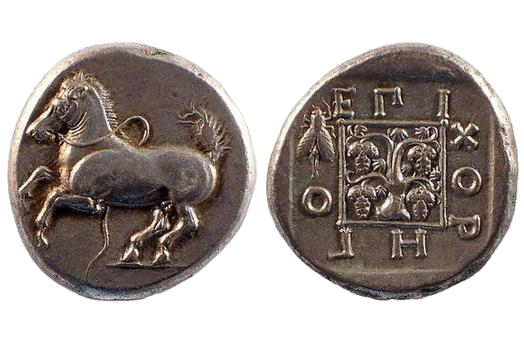
about ancient nomos
Ancient Nomos Art is a museum of galleries exhibiting ancient coins and ancient mint maps. The coin gallery displays the diverse art and history of hand-crafted ancient Greek, Roman, Byzantine, Persian and Medieval coinage. The ancient mints mapping gallery features Greek, Roman, Byzantine, Asia Minor and Medieval mint city regions and territories. Visitor's are welcome to explore, study and enjoy Ancient Nomos Art.

Greek, Thrace – 386 BC
Maroneia
From Ancient Galleries

Obverse: Bare back Horse rearing forepart upwards to the left and trailing rein.
Reverse: Greek inscription around arbor in linear square, Cicada to upper right.
LEGEND SYMBOLS
Obv. Horse rearing up to the left, trailing rein. Rev. ΕΠ І-ΧΟΡ-ΗΓ-Ο (Chorego, magistrate) around grape arbor in linear square; Cicada to the upper right; all within a shallow incuse square.
The ancient city of Maroneia is located on the SW slopes of Ismaros, Thrace. Thought to have been discovered by Chian colonists in the 7th century BC, Maroneia developed into a very prosperous Greek city-state known for its great wine, vineyards and thoroughbred horses. The ancient city name is said to be a priest of Apollo, Maron, who is featured in Homer’s work The Odyssey. Homer writes of Maron as a welcoming figure who gave gifts to Ulysses when he came and visited the land of the Kikones. Maroneia’s large herds of elegant horses and vast fields of quality grape vineyards are made into prominent classical symbols on all its coinage (See: Maroneia Tetrobol). This coin is a delightful masterpiece that was created in Maroneia between 386-348 BC. The tetradrachms obverse depicts a stallion rearing on hind legs to the left, perhaps starting to gallop. The loose, trailing rein, is free flowing over the horses back, delicately falling downward to the fore and past the ground line below. Even the long hairs of his waving tail are dynamic, excitedly flexing and curling upward. The coin reverse depicts the sinuous profile of an arbor grape vine supporting four grape bunches, all within a square frame. The Greek legend for the coins issuing magistrates, ΕΠΙ — ΧΟΡΗΓΟ (Chorego), is engraved around the grape vine frame. An upward resting Cicada insect is found at the top left corner. Horses and grapes undoubtedly held special significance as emblems and propaganda symbols for Maroneia. The city of Maroneia issued coins for several hundred years, with a vast distribution that circulated throughout the entire ancient Mediterranean world. Maroneia is a true testament to the unity, endurance and alliance formed by this splendid ancient Greek city.
DOCUMENTATION
Value: Tetradrachm. Metal: AR Silver. Weight: 11.44 grams. Mint: Maroneia. Date: c.386-347 BC.
Attribution: Schönert-Geiss 444 (V17/R29); West 107 & 112 (same dies); SNG Copenhagen 606, McClean 3961, Boston MFA 813; Weber, Plate 90, 2334.
Legend, Documentation and Attribution
